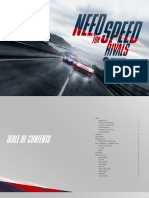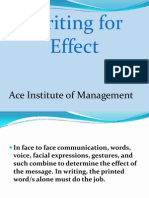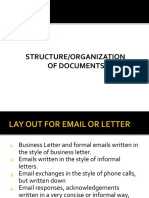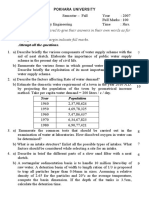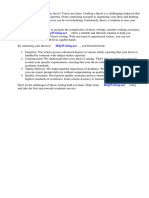Cliquez Ici Pour Regarder Le Cours en Français
Cliquez Ici Pour Regarder Le Cours en Français
Uploaded by
sushilCopyright:
Available Formats
Cliquez Ici Pour Regarder Le Cours en Français
Cliquez Ici Pour Regarder Le Cours en Français
Uploaded by
sushilOriginal Description:
Original Title
Copyright
Available Formats
Share this document
Did you find this document useful?
Is this content inappropriate?
Copyright:
Available Formats
Cliquez Ici Pour Regarder Le Cours en Français
Cliquez Ici Pour Regarder Le Cours en Français
Uploaded by
sushilCopyright:
Available Formats
Introduction
The subject of this short course is proposal writing. But the proposal does not stand alone. It must be part of a process of
planning and of research on, outreach to, and cultivation of potential foundation and corporate donors.
This process is grounded in the conviction that a partnership should develop between the nonprofit and the donor. When
you spend a great deal of your time seeking money, it is hard to remember that it can also be difficult to give money away.
In fact, the dollars contributed by a foundation or corporation have no value until they are attached to solid programs in the
nonprofit sector.
This truly is an ideal partnership. The nonprofits have the ideas and the capacity to solve problems, but no dollars with
which to implement them. The foundations and corporations have the financial resources but not the other resources
needed to create programs. Bring the two together effectively, and the result is a dynamic collaboration.
You need to follow a step-by-step process in the search for private dollars. It takes time and persistence to succeed. After
you have written a proposal, it could take as long as a year to obtain the funds needed to carry it out. And even a perfectly
written proposal submitted to the right prospect might be rejected for any number of reasons.
Raising funds is an investment in the future. Your aim should be to build a network of foundation and corporate funders,
many of which give small gifts on a fairly steady basis and a few of which give large, periodic grants. By doggedly pursuing
the various steps of the process, each year you can retain most of your regular supporters and strike a balance with the
comings and goings of larger donors.
The recommended process is not a formula to be rigidly adhered to. It is a suggested approach that can be adapted to fit
the needs of any nonprofit and the peculiarities of each situation. Fundraising is an art as well as a science. You must bring
your own creativity to it and remain flexible
Gathering Background Information
The first thing you will need to do in writing your proposal is to gather the documentation for it. You will require
background documentation in three areas: concept, program, and expenses.
If all of this information is not readily available to you, determine who will help you gather each type of information. If you
are part of a small nonprofit with no staff, a knowledgeable board member will be the logical choice. If you are in a larger
agency, there should be program and financial support staff who can help you. Once you know with whom to talk, identify
the questions to ask.
This data-gathering process makes the actual writing much easier. And by involving other stakeholders in the process, it
also helps key people within your agency seriously consider the project's value to the organization.
Concept
It is important that you have a good sense of how the project fits with the philosophy and mission of your agency. The
need that the proposal is addressing must also be documented. These concepts must be well-articulated in the proposal.
Funders want to know that a project reinforces the overall direction of an organization, and they may need to be
convinced that the case for the project is compelling. You should collect background data on your organization and on the
need to be addressed so that your arguments are well-documented.
Program
Here is a check list of the program information you require:
the nature of the project and how it will be conducted;
the timetable for the project;
the anticipated outcomes and how best to evaluate the results; and
staffing and volunteer needs, including deployment of existing staff and new hires.
Expenses
You will not be able to pin down all the expenses associated with the project until the program details and timing have
been worked out. Thus, the main financial data gathering takes place after the narrative part of the master proposal has
been written. However, at this stage you do need to sketch out the broad outlines of the budget to be sure that the costs
are in reasonable proportion to the outcomes you anticipate. If it appears that the costs will be prohibitive, even with a
foundation grant, you should then scale back your plans or adjust them to remove the least cost-effective expenditures.
Note writing
Dear Lisa,
I have got two tickets to the old film Gone with Wind at the new cinema near your
home. Please meet me at the Children Park on Sunday afternoon, at 4. After the film, we
may dine out in a restaurant. If you can’t come, call me as soon as possible or leave a
message in my mail box.
Yours,
Paul
Postponing an appointment
Feb. 28th
Nancy,
I am sorry to tell you I have to postpone our appointment at 4 o’clock tomorrow
afternoon, because I have to meet my sister at the airport at 5. Shall we discuss the matter at
4 p.m. the day after tomorrow? If it isn’t convenient for you, please ring me to make another
time. Thanks a lot.
Yours,
Jim
Cancelling an appointment
March 1st
Dear Karl,
I have to cancel the meeting we set on Thursday, March 6 th, at 10 p.m., because we have
got a little trouble on the farm, so I have to go there to handle the problem. I should be back
on March 10th and will call you then to for another appointment.
Thank you for your understanding.
Sincerely yours,
Jim
Sample Memo Format
Company Name
Company Address
Date of Memo
To: Recipient of Memo
From: Writer of Memo Writer's Initials*
Subject: Title of Memo in Initial Capitals
Engineers and scientists use memos to make requests, to give
announcements, and sometimes to communicate reports. Memos
that make requests or announcements are read quickly. For such
memos, get to the point in the first paragraph--the first sentence, if
possible. In other words, state what you want up front. In the
format suggested here, you should single space your memos and
use a serif typeface. Skip a line between paragraphs. The
following link shows this format in a pdf display.
In memos that make requests or announcements, keep the
sentence lengths and paragraph lengths relatively short. Sentences
should average fewer than twenty words, and paragraphs should
average fewer than seven lines. Also, keep the total memo length
to under one page, if possible.
Sometimes companies use memos to communicate short reports
(two pages or more). For these types of memos, the format
changes, as shown in the following example. For instance, you
often include illustrations, attach appendices, and break the
memo's text into sections. If references arise in the memo, you
include a list at the end. In memos that act as reports, the style
changes as well. For instance, the sentences and paragraphs are
typically longer than in memos that simply provide announcements
or make requests.
For all types of memos, space your memo on the page so that it
does not crowd the top. Also, send copies to anyone whose name
you mention in the memo or who would be directly affected by the
memo. Finally, remember that final paragraphs of memos that
make requests or announcements should tell readers what you
want them to do or what you will do for them.
Attachments.
Copy to:
Name to Receive Copy
Name to Receive Copy
*Initials should be written in ink
Last updated 05/2007
http://writing.eng.vt.edu/
You might also like
- Keyboarding Basics - Filled in NotesDocument7 pagesKeyboarding Basics - Filled in NotesGanesan100% (4)
- Email Writing WorksheetDocument9 pagesEmail Writing WorksheetjoseNo ratings yet
- Need For Speed Rivals - ToolkitDocument38 pagesNeed For Speed Rivals - Toolkitacdesign55100% (1)
- A Workshop On BWSDocument44 pagesA Workshop On BWSManjeet DeswalNo ratings yet
- U1 - Writing GuideDocument2 pagesU1 - Writing Guide27. Tu PhuongNo ratings yet
- Bus Part B1P WritingBankDocument8 pagesBus Part B1P WritingBankk62.2314810039No ratings yet
- Making Appointments by EmailDocument31 pagesMaking Appointments by EmailWilliamNo ratings yet
- Formal Informal EmailsDocument5 pagesFormal Informal EmailschantalNo ratings yet
- Unit7Application LettersDocument7 pagesUnit7Application LettersMarius MateiNo ratings yet
- Bus Part TBB1 WritingbankDocument8 pagesBus Part TBB1 Writingbank1987 - Võ Thị Xuân Nhi - NCTNo ratings yet
- Communication in The Professions 1Document53 pagesCommunication in The Professions 1Purple BlueNo ratings yet
- Paul Writing NotesDocument18 pagesPaul Writing NotesPaulIsaac 0518No ratings yet
- Business WritingDocument10 pagesBusiness WritingAna Lyn100% (1)
- Guide To Basic Business LettersDocument111 pagesGuide To Basic Business LettersMilica DujakovićNo ratings yet
- 3.writing For EffectDocument47 pages3.writing For Effectsajal_stha205_954707No ratings yet
- How To Approach EmployersDocument2 pagesHow To Approach EmployersJasmine NguyenNo ratings yet
- PB4MAT+Formal InformalDocument23 pagesPB4MAT+Formal InformalEryell Zivana AntoniNo ratings yet
- ENG 21 CHAPTER 5 Edited 2Document37 pagesENG 21 CHAPTER 5 Edited 2gizmoofordayouuNo ratings yet
- Emailing An Employer About A Job or Opportunity OpeningDocument2 pagesEmailing An Employer About A Job or Opportunity OpeningMichelléBranyakNo ratings yet
- Unit 1 1Document16 pagesUnit 1 1Linh Nhi PhạmNo ratings yet
- WRITINGDocument3 pagesWRITINGtennguoidung14122003No ratings yet
- Greetings Formal: This Is To Invite You To Join Us For..Document7 pagesGreetings Formal: This Is To Invite You To Join Us For..Maria Paz GarciaNo ratings yet
- Unit 4Document20 pagesUnit 4Loraine LepersNo ratings yet
- Unit 02Document6 pagesUnit 02FatimaNo ratings yet
- GreetingsDocument6 pagesGreetingsIshu RaiNo ratings yet
- Article - 6 Deadly Sins of E-WritingDocument8 pagesArticle - 6 Deadly Sins of E-Writingshubhamsharma2020No ratings yet
- B1 Writing BankDocument5 pagesB1 Writing BankThuỷ Nguyễn ThanhNo ratings yet
- Application Letter PTTDocument15 pagesApplication Letter PTTDesi MariyantiNo ratings yet
- How To Write A Formal EmailessDocument3 pagesHow To Write A Formal Emailessdima sinnoNo ratings yet
- EmailDocument16 pagesEmailRadhika KaduNo ratings yet
- Business English DialoguesDocument6 pagesBusiness English DialoguesAyesha ShahzadNo ratings yet
- Key - Writing Test 6Document3 pagesKey - Writing Test 6Nguyen LinhNo ratings yet
- Topic 5 1 Resume The ApplicationDocument8 pagesTopic 5 1 Resume The ApplicationАня ЯценикNo ratings yet
- Chapter-5. Business Letter. Cover Letter. Resume - FINALDocument37 pagesChapter-5. Business Letter. Cover Letter. Resume - FINALReslyn GarciaNo ratings yet
- BCL Report-1Document42 pagesBCL Report-1NIVETHITHA SNo ratings yet
- Tugas Bahasa Inggris Bisnis Letter of EnquiryDocument10 pagesTugas Bahasa Inggris Bisnis Letter of EnquiryStefanus Do WeNo ratings yet
- E Mail ExercisesDocument2 pagesE Mail Exercisesyash.ishwar.shahNo ratings yet
- Meetings in EnglishDocument17 pagesMeetings in EnglishSameera NishshankaNo ratings yet
- Writing Linguaskill PracticeDocument12 pagesWriting Linguaskill PracticeDiana CamachoNo ratings yet
- GTwrite 1Document14 pagesGTwrite 1Marina RadmanNo ratings yet
- TATM2 - EmailsDocument4 pagesTATM2 - EmailsphambichkhuyennNo ratings yet
- Caw 6-4Document2 pagesCaw 6-4api-736506490No ratings yet
- Phrasal Verbs in Business American English Student Ver2Document4 pagesPhrasal Verbs in Business American English Student Ver2Felipe OliveiraNo ratings yet
- 7 cs of communicationDocument85 pages7 cs of communicationbk5179562No ratings yet
- LeydianeSouza - S40057348 - Leadership Communication - Ass2Document6 pagesLeydianeSouza - S40057348 - Leadership Communication - Ass2Leydiane CostaNo ratings yet
- Phrasal Verbs in Business British English Student B2 C1Document4 pagesPhrasal Verbs in Business British English Student B2 C1Paula ReskyNo ratings yet
- 10.1 Using Diplomatic Language - 2Document4 pages10.1 Using Diplomatic Language - 2pont.moeeisanNo ratings yet
- RWS Business Writing H1 IntroductionDocument12 pagesRWS Business Writing H1 IntroductionPamela Abegail MonsantoNo ratings yet
- Phrasal Verbs in Business British English TeacherDocument5 pagesPhrasal Verbs in Business British English TeacherAnna Mushenko100% (1)
- Attractions For Adults. I Offered Him Our Very Good Theatre That PlaysDocument14 pagesAttractions For Adults. I Offered Him Our Very Good Theatre That PlaysSopphia CalopeNo ratings yet
- Doing Effective Business CorrespondenceDocument48 pagesDoing Effective Business Correspondencegetokhan30No ratings yet
- Writing Professional E-Mails - Key ExpressionsDocument11 pagesWriting Professional E-Mails - Key ExpressionsMuhammad Qasim UllahNo ratings yet
- 200+ Good Impromptu Speech TopicsDocument7 pages200+ Good Impromptu Speech TopicsJasmine EngNo ratings yet
- Business EmailsDocument4 pagesBusiness EmailsMarga Aboitiz100% (1)
- Master Public Speaking SkillsDocument103 pagesMaster Public Speaking SkillsmarvelbfabroNo ratings yet
- Writing-Emails-C1level StudentDocument5 pagesWriting-Emails-C1level StudentEnisa MesetovicNo ratings yet
- Fluentu 20 Key Phrases For Successful International Business Meetings in English PDFDocument5 pagesFluentu 20 Key Phrases For Successful International Business Meetings in English PDFCindyZOUKNo ratings yet
- Business Communication QuizDocument2 pagesBusiness Communication QuizPhạm Quỳnh TrangNo ratings yet
- Jai Communication Assignment Sem 2Document6 pagesJai Communication Assignment Sem 2nonujain12091999No ratings yet
- Paper Bi Paper Revision 2023Document5 pagesPaper Bi Paper Revision 2023JuitaNabeehaNo ratings yet
- email-style-american-english-teacher-ver2-1-4Document4 pagesemail-style-american-english-teacher-ver2-1-4aissa agoujilNo ratings yet
- Off the Top of My Head: 300 American Workplace Idioms for People Who Speak English as a Second LanguageFrom EverandOff the Top of My Head: 300 American Workplace Idioms for People Who Speak English as a Second LanguageRating: 5 out of 5 stars5/5 (1)
- Steel Moment-Resisting Frame 1994 Northridge Earthquake Federal Emergency Management AgencyDocument1 pageSteel Moment-Resisting Frame 1994 Northridge Earthquake Federal Emergency Management AgencysushilNo ratings yet
- Candidates Are Required To Give Their Answers in Their Own Words As Far As Practicable. The Figures in The Margin Indicate Full MarksDocument2 pagesCandidates Are Required To Give Their Answers in Their Own Words As Far As Practicable. The Figures in The Margin Indicate Full MarkssushilNo ratings yet
- Candidates Are Required To Give Their Answers in Their Own Words As Far As Practicable. The Figures in The Margin Indicate Full MarksDocument2 pagesCandidates Are Required To Give Their Answers in Their Own Words As Far As Practicable. The Figures in The Margin Indicate Full MarkssushilNo ratings yet
- Water Resource Engineering IIDocument2 pagesWater Resource Engineering IIsushilNo ratings yet
- Candidates Are Required To Give Their Answers in Their Own Words As Far As Practicable. The Figures in The Margin Indicate Full MarksDocument2 pagesCandidates Are Required To Give Their Answers in Their Own Words As Far As Practicable. The Figures in The Margin Indicate Full MarkssushilNo ratings yet
- Candidates Are Required To Give Their Answers in Their Own Words As Far As Practicable. The Figures in The Margin Indicate Full MarksDocument2 pagesCandidates Are Required To Give Their Answers in Their Own Words As Far As Practicable. The Figures in The Margin Indicate Full MarkssushilNo ratings yet
- System Software 2009 (Back)Document1 pageSystem Software 2009 (Back)sushilNo ratings yet
- Candidates Are Required To Give Their Answers in Their Own Words As Far As Practicable. The Figures in The Margin Indicate Full MarksDocument2 pagesCandidates Are Required To Give Their Answers in Their Own Words As Far As Practicable. The Figures in The Margin Indicate Full MarkssushilNo ratings yet
- Candidates Are Required To Give Their Answers in Their Own Words As Far As Practicable. The Figures in The Margin Indicate Full MarksDocument2 pagesCandidates Are Required To Give Their Answers in Their Own Words As Far As Practicable. The Figures in The Margin Indicate Full MarkssushilNo ratings yet
- Candidates Are Required To Give Their Answers in Their Own Words As Far As Practicable. The Figures in The Margin Indicate Full MarksDocument2 pagesCandidates Are Required To Give Their Answers in Their Own Words As Far As Practicable. The Figures in The Margin Indicate Full MarkssushilNo ratings yet
- Candidates Are Required To Give Their Answers in Their Own Words As Far As Practicable. The Figures in The Margin Indicate Full MarksDocument2 pagesCandidates Are Required To Give Their Answers in Their Own Words As Far As Practicable. The Figures in The Margin Indicate Full MarkssushilNo ratings yet
- Candidates Are Required To Give Their Answers in Their Own Words As Far As Practicable. The Figures in The Margin Indicate Full MarksDocument2 pagesCandidates Are Required To Give Their Answers in Their Own Words As Far As Practicable. The Figures in The Margin Indicate Full MarkssushilNo ratings yet
- Water Resource Engineering IDocument3 pagesWater Resource Engineering IsushilNo ratings yet
- Candidates Are Required To Give Their Answers in Their Own Words As Far As Practicable. The Figures in The Margin Indicate Full MarksDocument2 pagesCandidates Are Required To Give Their Answers in Their Own Words As Far As Practicable. The Figures in The Margin Indicate Full MarkssushilNo ratings yet
- Candidates Are Required To Give Their Answers in Their Own Words As Far As Practicable. The Figures in The Margin Indicate Full MarksDocument2 pagesCandidates Are Required To Give Their Answers in Their Own Words As Far As Practicable. The Figures in The Margin Indicate Full MarkssushilNo ratings yet
- Water Supply EngineeringDocument2 pagesWater Supply EngineeringsushilNo ratings yet
- Candidates Are Required To Give Their Answers in Their Own Words As Far As Practicable. The Figures in The Margin Indicate Full MarksDocument2 pagesCandidates Are Required To Give Their Answers in Their Own Words As Far As Practicable. The Figures in The Margin Indicate Full MarkssushilNo ratings yet
- Water Supply Engineering Set IIDocument2 pagesWater Supply Engineering Set IIsushilNo ratings yet
- Candidates Are Required To Give Their Answers in Their Own Words As Far As Practicable. The Figures in The Margin Indicate Full MarksDocument2 pagesCandidates Are Required To Give Their Answers in Their Own Words As Far As Practicable. The Figures in The Margin Indicate Full MarkssushilNo ratings yet
- Fly Level Booking Sheet Project:-Location:-: S.no BS IS FS Rise Fall HI Reduced LevelDocument2 pagesFly Level Booking Sheet Project:-Location:-: S.no BS IS FS Rise Fall HI Reduced LevelsushilNo ratings yet
- Mechanism of LubricationDocument1 pageMechanism of LubricationsushilNo ratings yet
- The22ImmutableLawsOfBranding BIZDocument16 pagesThe22ImmutableLawsOfBranding BIZRaja Sufyan MinhasNo ratings yet
- IT 123 (Week 02 & 03)Document19 pagesIT 123 (Week 02 & 03)Louie Jay Flores CandameNo ratings yet
- Cie Igcse Ict 0417 Practical v1 Znotes 1Document3 pagesCie Igcse Ict 0417 Practical v1 Znotes 1wynterflorenceNo ratings yet
- FS-1020D DS en PDFDocument2 pagesFS-1020D DS en PDFBartha RemusNo ratings yet
- Cad Lab Manual 2018-19Document61 pagesCad Lab Manual 2018-19M NANDITHA CIVIL STAFFNo ratings yet
- Pages Mac Thesis TemplateDocument6 pagesPages Mac Thesis Templatekatherinealexanderminneapolis100% (2)
- Template For Preparation of Manuscripts For Nano Research: Table of Contents (Toc)Document6 pagesTemplate For Preparation of Manuscripts For Nano Research: Table of Contents (Toc)anjanbsNo ratings yet
- The Silver Editorial Font Webfont & Desktop MyFontsDocument1 pageThe Silver Editorial Font Webfont & Desktop MyFontsdenipovsNo ratings yet
- Crossword Forge 5.6: What's New: Version 5.6 (August 11, 2009)Document48 pagesCrossword Forge 5.6: What's New: Version 5.6 (August 11, 2009)Latoya AndersonNo ratings yet
- Preparing Professional PowerPoint PresentationsDocument11 pagesPreparing Professional PowerPoint PresentationsRamesh KumarNo ratings yet
- 0417 s09 QP 2 PDFDocument7 pages0417 s09 QP 2 PDFSrikrupa SudheendraNo ratings yet
- Lyft GuidelineDocument18 pagesLyft GuidelineNguyễn Mỹ LinhNo ratings yet
- MetLife Abbreviated-2020Document39 pagesMetLife Abbreviated-2020Paula GonzalezNo ratings yet
- SPC NP LayoutDocument16 pagesSPC NP LayoutAshley BruasNo ratings yet
- Keys To Effective Journalism in The Multimedia EraDocument13 pagesKeys To Effective Journalism in The Multimedia EraMeryl Julienne MacenasNo ratings yet
- Mil q2 Module 4 FinalDocument20 pagesMil q2 Module 4 FinalYve LuelleNo ratings yet
- Dept of Mca: G.L. Bajaj Institute of Technology & Management, Greater NoidaDocument4 pagesDept of Mca: G.L. Bajaj Institute of Technology & Management, Greater NoidaSatyam SrivastavaNo ratings yet
- Style File IjsmmDocument4 pagesStyle File Ijsmmbahrul.hidayah@yahoo.comNo ratings yet
- Cs-784: Multimedia Systems: Dereje Teferi (PHD) Dereje - Teferi@Aau - Edu.EtDocument33 pagesCs-784: Multimedia Systems: Dereje Teferi (PHD) Dereje - Teferi@Aau - Edu.EtdaveNo ratings yet
- Screenplays Are Traditionally Written in Courier 12 PT Font On 8Document1 pageScreenplays Are Traditionally Written in Courier 12 PT Font On 8Nora Abu BakarNo ratings yet
- DyshdDocument7 pagesDyshdmeme2345315No ratings yet
- Rotman Graphic StandardsDocument30 pagesRotman Graphic StandardsamyNo ratings yet
- Map DesignDocument10 pagesMap Designgreyproperties88No ratings yet
- Hand Lettering and Modern Calligraphy For Beginners - Learn The Art of Creative LetteringDocument166 pagesHand Lettering and Modern Calligraphy For Beginners - Learn The Art of Creative LetteringTor 173% (11)
- Itc Ot CDDocument5 pagesItc Ot CDjacksternNo ratings yet
- TypographyDocument3 pagesTypographyChandria MedinaNo ratings yet
- DHMBussComp Chapter-3 PDFDocument53 pagesDHMBussComp Chapter-3 PDFarvinNo ratings yet
- Norfolk DocumentationDocument5 pagesNorfolk DocumentationRufus LoackerNo ratings yet


